

Public ublic In Inform rmatio tion Meetin ting Ma Madi dison son Av Avenue Ro Road Di Diet et Albany, NY 29 July 2015 3M Multi ‐ Modal Plan, St. Paul, MN Photo Credit: Bike Walk Wichita
Welcome Purpose of Meeting • Introduce Project • Brief History • Alternatives (pros / cons) • Schedule • Obtain Input Meeting Outline • Technical Presentation • Q & A • Ranking Activity
Project Area
Feasibility Study Recap Current layout of Madison Avenue Existing • 4 ‐ lanes • Parking • 57’ curb to curb space • 15,000 AADT Conclusions • Diet is Feasible • Safety Benefits • Coordinate Signals (some delay increase) • Confirm configuration during design.
“Balance” Design Considerations for: Pedestrians • Cyclists • Transit • Motor Vehicles •
Different Types of Cyclists 7% 32% Strong and fearless Enthused and confident Those who bike out of necessity “No way, no how” Interested but concerned
Bike Facility Typology Least protected Strong and fearless Enthused and confident Separated Bike Lanes Interested but concerned Most protected *FHWA Separated Bike Lane Planning & Design Guide
Bicycle Ridership Increases To Conventional Separated Bicycle Lanes Bicycle Lanes F No Bike 57% 90% R One study Average of 7 Facility studies O M Conventional ‐ 56% Average of 9 Bike Lanes studies
Bike Counts Average of 30 bikes per hour on Madison Ave *Albany Department of Development and Planning – Semiannual bike counts
Design Alternatives Existing 4 ‐ Lane Section 3 ‐ Lane Road Diet A. Marked Shared Lanes 3 ‐ Lane Section B. Conventional Bicycle Lanes C. Two ‐ way Separated Bicycle Lanes 2 ‐ Lane Road Diet 2 ‐ Lane Section D. One ‐ way Separated Bicycle Lanes E. Buffered Bicycle Lanes
A. Marked Shared Lanes Pros • More room for maneuvering • Avoids bicycle conflicts w/ parked vehicles Promotes driver awareness of • need to share the road • Low maintenance costs • Winter maintenance Cons No buffer zone • Lower bicycle comfort level • • Higher conflict areas • Wider lanes may result in higher speeds
A. Marked Shared Lane Intersections
B. Conventional Bicycle Lanes Pros • Bikes have dedicated road space Flexibility for emergency • vehicles & intermittent load / unload operations to enter lane • Meets minimum required widths (NACTO + AASHTO) • Winter maintenance Cons • Cyclists in “door zone” No vertical protection (not • physically separated) • Parking vehicles must cross the bike lane
B. Conventional Bicycle Lane Intersections (1)
B. Conventional Bicycle Lane Intersections (2)
C. Two ‐ way Separated Bicycle Lanes Pros • Physically separated • High comfort levels High visibility • Cons High maintenance costs • Expensive Facility • • Narrow lanes • Poor Transitions / Entry
C. Two ‐ way Separated Bicycle Lane Intersections
D. One ‐ way Separated Bicycle Lanes Pros • Physically separated • High comfort levels High visibility • Traffic calming • Cons Higher maintenance • costs • Expensive Facility Parking Reductions at • Intersections • More vehicle delay (parking / loading / unloading, mid ‐ block turning)
D. One ‐ way Separated Bicycle Lane Intersections
E. Buffered Bike Lanes Pros • Separated bicycle space High comfort levels • High visibility • Distance from door zone • • Winter maintenance • Traffic calming Cons Not physically separated • • Parking Reductions at Intersections More segment delay (parking / • loading / unloading, mid ‐ block turning) • Cost to maintain pavement markings
E. Buffered Bicycle Lane Intersections
Pros / Cons Summary Considerations for the development of Pros/Cons: • Pedestrian Comfort / Access • Bicycle Comfort / Access • Transit Access • Traffic Flow vs Traffic Calming • Emergency Vehicle Access • Capital Costs • Maintenance • Parking Impacts • Community
Phasing
Open House / Ranking Activity Following Q&A, we will transition into the open house… • Visit all of the stations around the room • Ask questions at any of the stations • Place a Like/Neutral/Dislike button on the stations Questions/Comments?
Thank you for attending! Contact: MadisonAveStudy@Albany ‐ NY.org William E. Trudeau, Jr. 518 ‐ 434 ‐ 5791
Recommend
More recommend